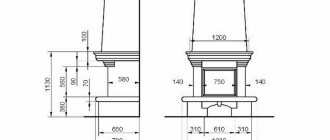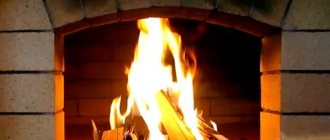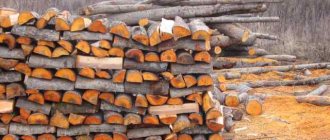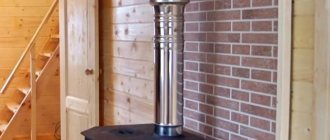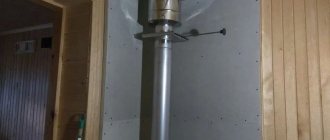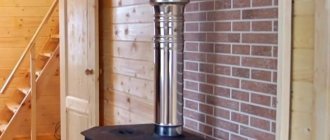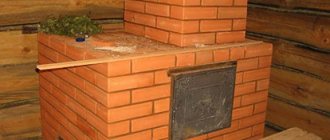Home / Ceiling design / Design solutions / The wall behind or near the fireplace or stove - how to decorate it?
When a fireplace or stove is lit, the wall near it becomes heated. This is unsafe if the walls and floor where the stove or fireplace is located are not properly finished. This part of the house structure must be insulated with fireproof materials that can completely prevent fire. In addition, you need to take into account the requirements for installing heating devices - the distance from the partitions.
Insulation options
There are many non-combustible materials that can be used in this case. The easiest way to protect all surfaces from heat is to place a protective box around a red brick heat source. It is able to protect structures from heat and easily tolerates thermal effects. However, this decoration of the wall around the stove in the house looks a little unaesthetic and you can choose other materials:
- Porcelain tiles and tiles.
- Fiber cement boards.
- Factory-made protective screens.
- Metal sheets.
- Artificial or natural stone.
The easiest way to work is with a ready-made protective screen - you just need to select it according to size and install it on site. This option is also good because such finishing of walls near the stove or fireplace is done in the shortest possible time and without “dirty” or “wet” finishing work. The remaining options are more labor-intensive and have some nuances. Therefore, they need to be considered in more detail.
Refractory materials for furnace lining
Fireclay materials for lining furnaces, namely brick and mortar, make it possible to create a protective fireproof screen both around the firebox and around the body of the metal furnace. The difference between a kiln brick screen and a lining screen is that the lining is a protective casing located close to the walls of the kiln.
Natural stone for finishing
Fireclay can withstand temperatures up to 1300 degrees. Today, in addition to bricks and mortar, there is also fireclay coating, glue, and mastic, which can be applied even while the stove or fireplace is operating. Their composition includes microscopic fireclay fibers and binding substances; they line the entire surface of the furnace and seal individual cracks. In addition, materials such as kaolin paper, kaolin cardboard, in the form of rolls and also kaolin wool in separate pieces are produced for lining.
Tile and porcelain stoneware
These two materials are best suited for insulation in this case, as they have a beautiful appearance and will not spoil the interior. However, in terms of labor intensity and costs, this will be the most complex method of registration. You will have to prepare the surface, stick the tiles and only then install the stove in place. At the same time, you will have to do without heat for some time, since the work is carried out in several stages and each takes time.
What parameters to pay attention to when choosing
When choosing thermal insulation, you need to pay attention to several points. Important criteria are the price of materials and work, as well as the installation method that will be carried out. At the same time, it is necessary to carefully analyze the characteristics of the selected option. These characteristics include:
Thermal conductivity. It is important that the piece of consumable you choose is not raw, otherwise it will not cope with the plans assigned to it.
Thermal conductivity depends on the degree of humidity, since water has the ability to transmit heat better than air. Non-flammable substances retain heat inside the product.
The porosity of the heat insulator. There are closed or open pores on the elements.
It is important to ensure that they are evenly distributed over the surface; these pores are involved in heat exchange and air circulation.
Rapid water absorption. This criterion shows how much water has accumulated and how much of it can be retained. To test water absorption, you need to place the item in a humid environment.
Density and vapor permeability. Density depends on its mass in combination with the volume of the source. The vapor permeability level shows how much steam can pass through non-combustible wall insulation in a certain period of time.
Resistant to biodegradation. If fire-resistant materials have high biological resistance, they will be able to resist insects and fungi in conditions of constant or simply high humidity.
Fire resistance and heat resistance. Emphasis on the flammability and combustibility of the material.
If the insulation can withstand flames, then the level is high.
Combustible substances are added, so during heating the level of heat reached is checked, as well as the stability of the properties during it. At high temperatures, characteristics may decrease, as well as strength, and as a result, quality.
Frost resistance. To check this parameter, insulating structures are placed in low temperatures and analyzed to see if their properties have been lost during freezing and thawing.
Minerite or fiber cement boards
This material is suitable for those cases when there is no desire to waste time on laying tiles or assembling a complex protective structure. The plates are mounted directly on the wall or on a specially prepared metal profile structure. In the first option, the plates are simply attached with self-tapping screws or using clamps. With clamps, a ventilation gap of three to five millimeters remains between the wall and the assembled surface, which further increases safety.
The second method is more complicated, but such finishing of the walls near the stove in the house will protect them much better from the heat. On the surface, using a construction stapler, basalt cardboard with a foil coating is attached, with foil inside the room. Metal profiles are attached through the cardboard to fix the external decorative panels. Decorative slabs are attached to the profiles in such a way that they do not reach the ceiling a few centimeters. This gap is necessary to compensate for possible shrinkage of the house. Ventilation holes are made in the bottom of the slabs, which can be covered with a decorative grille.
Installation work stages
Installing fire-resistant panels will not take much of your time and effort, however, you must adhere to a certain consistency. To install, follow these steps:
The panel to be mounted must be attached to a perfectly flat wall. If there is no flat surface, it must be mounted on a sheathing. In the first case, self-tapping screws and heat-resistant glue act as fastenings.
For interior wall decoration, you can attach the product to a metal profile. To do this, a structure is created that resembles the letter “P” in shape. To attach the plywood, self-tapping screws are used, and the screw-in points will need to be puttied.
Installation of the final layer is carried out using self-tapping screws and metal clamps. Using clamps, it is possible to carry out hidden installation, as a result of which the external decorative appearance of the object is not spoiled.
A small recommendation: using mineralite slabs or asbestos sheets for installation, you should use screws for fastening.
Fibrous refractory material will not add heaviness to the structure, but it also needs strengthening. When using fireclay bricks, you can use solutions based on light clays, and the solution should not contain a large amount of sand. You can give a decorative and bright look using frisol.
Regardless of what kind of building element you install around the stoves, you need to take heat-resistant glue. With it, it is more likely that your design will be durable.
Source
Metal sheet
This protection option can be used when the distance between the walls of the stove or fireplace and the protected surface is more than 20 centimeters. The sheet is simply attached to the surface so that its edges protrude beyond the edges of the heating device by 30 centimeters on each side. The option is unreliable and is not recommended for use if the heat source is not removed from the partitions at the specified distance - the risk of fire remains.
Protective non-combustible wall coverings
If there is no need to carry out work to protect walls using screens, in this case, you will still need to reliably protect the surfaces from exposure to high temperatures.
You can use classic mineral wool or use mineralite slabs. We get a reduction in the distance from the wall to the stove in the house, without the risk of fire and deformation of building materials.
Installation of reflective trim
This is one of the main methods of protecting surfaces from high temperatures. To do this, you can use a sheet of thin cold-rolled metal with its glossy surface or buy more expensive stainless steel sheets with a mirrored face. This heat-reflecting protection allows you to quickly heat the room without wasting firewood and reliably protects the walls and ceiling from deformation.
First, the sheathing strips are secured. The bars should be selected taking into account the thickness of the insulating material. A thermal insulation layer is embedded in the spaces between the sheathing parts. On top of it, sheets of reflective sheathing are attached to wood or metal screws (this depends on the material of the bars).
Using this method of protection, you can reduce the distance from the stove to the wall to 380 mm.
Protecting walls from the heat of the stove can be used as decorative decoration for premises.
Installation of sheathing with cladding
This method will require increased costs for the purchase of materials, but will also make your home cozy and beautiful. Porcelain stoneware or expensive tiles can be used as cladding, it all depends on the capabilities of the owner of the house.
Work on the protection and decorative finishing of walls is carried out in several stages, the result is a kind of cake:
Using this method, you can reliably isolate the stove from the wall and make a gap of 150 mm between them.
Stone
This type of wall decoration behind the stove or fireplace is very beautiful. However, this is also the most expensive finishing method if natural material is used. Artificial stone is cheaper, but it also falls into the category of expensive decoration. The surface is prepared using standard technology, and the heating device is installed after all finishing has been completed.
The wall behind or near the fireplace or stove - how to decorate it?
When a fireplace or stove is lit, the wall near it becomes heated. This is unsafe if the walls and floor where the stove or fireplace is located are not properly finished. This part of the house structure must be insulated with fireproof materials that can completely prevent fire. In addition, you need to take into account the requirements for installing heating devices - the distance from the partitions.
What else to consider
To avoid any troubles during the operation of the furnace, you need to take into account the requirements of SNiP in all cases - even with installed protection, even without it. They are simple and compliance with these rules guarantees you the necessary level of protection:
- The distance from unprotected wooden walls to the heating device is 1000 mm.
- If the wall is protected by a material equivalent in thermal conductivity to brick - 130 mm.
- If the floor is not protected by anything, then the distance to the bottom side of the heater should be at least 140 mm.
The floor is best protected with ceramic tiles or porcelain stoneware. You can also use a mineralite slab or a regular sheet of metal. It is most important to protect the area directly in front of the firebox door, as embers can fall out and cause a fire. Directly under the heating device, the floor covering does not heat up particularly strongly and if a distance of 4 - 15 centimeters to the bottom of the oven is maintained, additional protection may not be needed there.
SNiP standards for the location of the furnace from the walls
The standards for these requirements are specified in 2 main documents:
Based on these regulatory documents, each owner of a solid fuel stove is required to maintain minimum clearances from the wall and ceiling, taking into account the surface material:
| Parameter | Requirement |
| Installing the stove on a floor made of flammable materials. | The distance to the bottom of the stove must be at least 140 mm. |
| Foundation size. | When installing a steel stove on a wooden floor, the size of the foundation should be 1000 mm larger than the dimensions of the stove. |
| The ceiling is protected by asbestos slabs, plaster and sheet metal up to 1 cm thick. | In this case, the brick-lined stove is made in height so that the gap to the ceiling is at least 250 mm. |
| When installing a steel stove with a protective layer of thermal insulation. | The minimum distance to the floor slab is 700 mm. |
| Installation of a steel stove without a protection layer. | This size increases to 1000 mm. |
| Minimum dimensions for walls according to SNIP from 1962 | |
| Distance from stove to wood stove with unprotected surface. | From 1000 mm. |
| The walls are lined with brick and plastered with lime mortar with a layer of 25 mm. Or an asbestos heat insulator 4 cm thick is fixed. | 130 mm |
| The wooden walls are lined with brick, 120 mm thick and plastered with lime and asbestos. When installing protection on the walls in the form of a 40 mm asbestos-vermuculite slab. | 300 mm |
By maintaining the minimum dimensions, or better yet, making gaps with a small margin, every owner of a wooden house can be sure that its walls and ceiling are protected from high temperatures.
One of the main methods of protection is the manufacture of devices installed to protect the front and side surfaces near the stove itself.
When it is necessary
When designing the space around a source of elevated temperature, you need to take some points into account. First of all, this concerns the distances at which it is necessary to place the firebox itself from the structures enclosing it. After all, different types of finishing have different properties and characteristics, which will reduce the required distance and increase the usable area of the room.
- If the distance between the brick stove and the wall is less than thirty-two centimeters, special design of the wooden walls will be required.
- It is recommended to leave at least a meter of free space from wooden surfaces before metal heaters.
- Lined fireboxes require a shorter distance - only seventy centimeters, which, however, is also a lot.
If the firebox is located further away, then you will only have to worry about protecting the floor. It is covered with refractory material directly under and near the heating device, in the area where the firebox door opens. Sometimes falling coals can cause a fire and the surface must be reliably protected.
Scope of use
The scope of use of fire-resistant materials is somewhat wider than non-combustible materials for finishing walls under a boiler, stove or fireplace. It also includes materials used for the construction and decoration of the heating devices themselves. Refractory bricks are used for laying the internal surfaces of stoves and fireplace inserts. Fire-resistant glass inserts are tripled in stove doors and fireplace protective screens. External finishing of heating devices is not only fire-resistant plaster for the stove, but also tiles and clinker used as facing material
Installing a fireplace in a wooden house
Despite the increased popularity of brick fireplaces, they have one serious drawback - the inability to efficiently warm up the entire house.
In addition, some of the heat escapes through the pipe. A more rational solution for a wooden house is to install a fireplace stove. This design makes it possible not only to heat the room, but also to cook food.
They are also easy to install and safer to use. If you need to heat a house with several floors, it is enough to connect a water heating circuit to the stove.
Modern fireplace stoves do not require design or professional installation; just choose the model you like and carry out a simple installation.
The main advantages of modern fireplaces:
- economical;
- equipped with systems for regulating combustion parameters;
- do not involve installing a solid foundation and creating protective walls in the house;
- have increased heat transfer;
- equipped with a closing firebox with heat-resistant self-cleaning glass;
- have a detachable ash pan;
- are able to heat the entire area of the house evenly.
Structurally, there are two types of such installations:
- with air heating system;
- with water heating system.
If the house has few interior partitions and is used as a summer house in which people live intermittently, an air heating system is quite suitable. For permanent residence, as well as in a multi-room or multi-story building, it is rational to use a water heating system. To do this, a water circuit is connected to the radiator.


